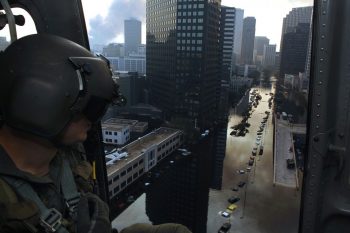
Communications have been a very big problem in emergency situations, especially during natural disasters such as storms and earthquakes where power grids, cell towers and internet cables are often damaged. This affects emergency response teams in reaching people in need, as there is no way to contact people unless they search throughout the whole debris caused by disasters.
Project OWL (Organization, Whereabouts and Logistics), winner of the 2018 Call for Code Challenge, a global initiative where developers and problem solvers build solutions that take on societal issues, found a solution for this, drawing inspiration from what happened in Puerto Rico given the impact of Hurricane Maria and the island’s challenging topography.
Bringing software and hardware together, Project OWL provides simple wireless devices equipped with IBM Watson™ Studio, Watson Cloud APIs and The Weather Company APIs. These small devices are enclosed in a waterproof case, with a small IoT computer board, a radio antenna and a battery pack.
This is how it works: each device, called DuckLink, is deployed in remote areas that are hard to reach for response teams, let’s say five DuckLinks to cover a square mile. These DuckLinks are equipped with LoRa (Long Range), WiFi and Bluetooth to connect with each other. Civilians can connect to these devices using their consumer electronics through WiFi, providing a simple portal for people to send their location through messages.
“When you have equipment that’s going to be used during a disaster, you have to keep it fairly simple”, one of the researchers said. “Not just because there might be people without the same education as you or the same technical background as you, but it needs to be very simple to operate under stress”.
DuckLinks can take any form and can be deployed before or during a disaster, from floating devices for floods, devices strapped in trees and even devices on drones to provide connectivity impromptu on harder to reach areas.
Then, these DuckLinks will relay messages to a hub called MaMaDuck, where it would send all messages to the PaPaDuck device. These PaPaDuck devices can connect to the OWL Data Management System via WiFi, LTE and satellite, where emergency response teams can see insights and data visualisations.
Together, these devices form a mesh network, which the researchers call ClusterDuck, effectively providing connectivity between people in distress during emergencies and response teams for rescue operations.
“A solution like OWL definitely could come in handy in an emergency like the one we had”, said Ruth Silva, Deputy to the Chief of Operations, ITDRC Puerto Rico, a Code and Response implementation partner. “There are other solutions like the hardware [and the software]. But this combination of both, it’s what makes it different and powerful”.
 (0)
(0) (0)
(0)Archive
- October 2024(44)
- September 2024(94)
- August 2024(100)
- July 2024(99)
- June 2024(126)
- May 2024(155)
- April 2024(123)
- March 2024(112)
- February 2024(109)
- January 2024(95)
- December 2023(56)
- November 2023(86)
- October 2023(97)
- September 2023(89)
- August 2023(101)
- July 2023(104)
- June 2023(113)
- May 2023(103)
- April 2023(93)
- March 2023(129)
- February 2023(77)
- January 2023(91)
- December 2022(90)
- November 2022(125)
- October 2022(117)
- September 2022(137)
- August 2022(119)
- July 2022(99)
- June 2022(128)
- May 2022(112)
- April 2022(108)
- March 2022(121)
- February 2022(93)
- January 2022(110)
- December 2021(92)
- November 2021(107)
- October 2021(101)
- September 2021(81)
- August 2021(74)
- July 2021(78)
- June 2021(92)
- May 2021(67)
- April 2021(79)
- March 2021(79)
- February 2021(58)
- January 2021(55)
- December 2020(56)
- November 2020(59)
- October 2020(78)
- September 2020(72)
- August 2020(64)
- July 2020(71)
- June 2020(74)
- May 2020(50)
- April 2020(71)
- March 2020(71)
- February 2020(58)
- January 2020(62)
- December 2019(57)
- November 2019(64)
- October 2019(25)
- September 2019(24)
- August 2019(14)
- July 2019(23)
- June 2019(54)
- May 2019(82)
- April 2019(76)
- March 2019(71)
- February 2019(67)
- January 2019(75)
- December 2018(44)
- November 2018(47)
- October 2018(74)
- September 2018(54)
- August 2018(61)
- July 2018(72)
- June 2018(62)
- May 2018(62)
- April 2018(73)
- March 2018(76)
- February 2018(8)
- January 2018(7)
- December 2017(6)
- November 2017(8)
- October 2017(3)
- September 2017(4)
- August 2017(4)
- July 2017(2)
- June 2017(5)
- May 2017(6)
- April 2017(11)
- March 2017(8)
- February 2017(16)
- January 2017(10)
- December 2016(12)
- November 2016(20)
- October 2016(7)
- September 2016(102)
- August 2016(168)
- July 2016(141)
- June 2016(149)
- May 2016(117)
- April 2016(59)
- March 2016(85)
- February 2016(153)
- December 2015(150)
